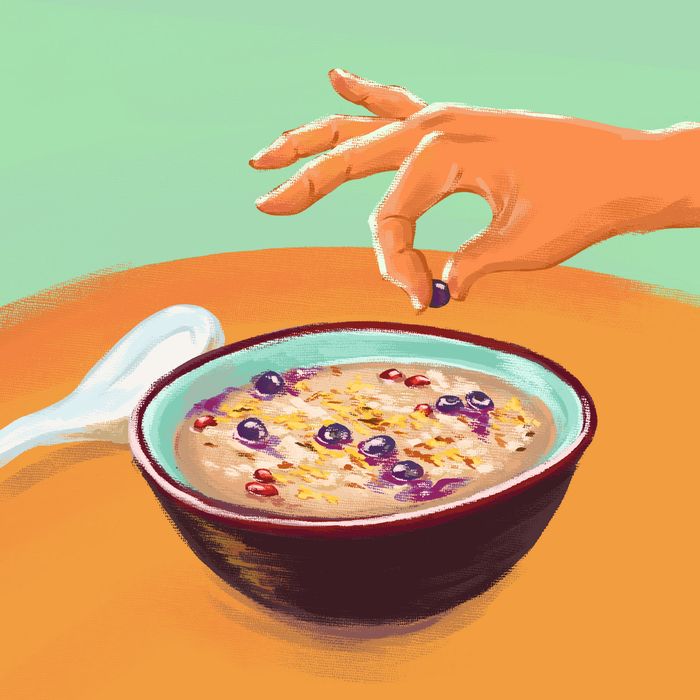
Last month, a small-business owner named Karen Taylor made national headlines for all the wrong reasons. After a viral tweet exposed the racist and orientalist language used to market Taylor’s company, which specializes in $15 prepackaged congee kits and is called Breakfast Cure, critics made quick work of tearing the self-styled “Congee Queen” to shreds. Taylor, who is white, eventually apologized, and an essay on her company’s website, which was originally titled “How I discovered the miracle of congee and improved it,” was quickly edited (although the original title is still easily found in the page’s metadata).
For a week, my Twitter timeline was filled with Asians and our allies airing their righteous anger, sharing touching personal testimonies on what congee meant to them, and ridiculing Karen’s “white lady” ingredients like blueberries, apples, and cinnamon. On TikTok, multiple POC creators uploaded videos of themselves trying — and choking on — Breakfast Cure–style congee.
As the mainstream media picked up the story, the narrative was quickly reduced to a familiar “offended POCs” versus “oblivious white people” tug-of-war over cultural ownership, a gatekeeping story at its heart. On one side, viral angry tweets paired with cultural experts who explained the harmful power dynamics of white colonialist practices. On the other side, canned contrition from the white offender and wishes that critics would be less hostile.
A few days after the story first broke, I was interviewed by USA Today. For close to an hour, I answered questions about the history and cultural significance of congee, and why Breakfast Cure sparked such a strong reaction from Asians. I drew on my experience as a former consumer-insight researcher based in China, and talked at length about how Taylor’s Chinese-medicine-focused brand positioning is extremely common in China, and about the popularity and versatility of congee that’s available to Chinese consumers. I emphasized that there’s nothing particularly sacred about the dish, that anyone can make it, but that it doesn’t make it okay for a white woman to anoint herself the Queen of Congee.
I didn’t expect all my quotes to make it into the article, but when it ran, I was bothered to see that the piece made no mention of the many modern congee iterations found across China, and instead focused on the dish’s status as a centuries-old staple, an angle that was also followed by outlets like the Washington Post and Insider. No outlet, as far as I know, informed its readers that blueberries, apples, cinnamon, while untraditional, are all ingredients you can find in Chinese congee recipes and even on the menus of congee restaurants, or that Taylor’s sin was not putting blueberries into congee — she’s not even the first to do so — but was instead claiming that her version, which she said had been modernized for the Western palate, was somehow superior to traditional congee from China.
In effect, media coverage has run with the same reductive orientalist cliché peddled by the Congee Queen: that congee, just like Chinese culture itself, is rigidly traditional, exotic, and unfamiliar to America; that it is steeped in history; and that any change or adjustment is to be regarded as blasphemy. In propagating a narrative that slow-cooked rice and water is considered sacred by Asians, while leaving out the more colorful and trendy aspects of congee’s culinary identity, media coverage does a disservice to readers by failing to shine a light on how inaccurate Karen Taylor’s portrayal of Chinese congee really is, while also failing to explain the more insidious essence of cultural appropriation.
Viewed another way, the flattened story allowed defenders of Taylor to portray her critics as an “Asian mob” canceling a white entrepreneur in a case of overblown cultural gatekeeping.
“Overcook your rice & you’ve culturally appropriated congee,” wrote one Twitter user snidely.
“Anyone has a right to make any food they want, by the way,” wrote another, bringing up a familiar refrain that fails to understand the existing power dynamics that dictate who gets to make and sell what food, and at what price.
It is not that Asians are offended by white people cooking and selling slow-cooked rice, which is what many articles implied. Even though the idea of cultural theft is the thrust of these stories, the real issue is disrespect: the way this kind of appropriation links Westernization and whitewashing with sophistication and value, while deeming nonwhite cultures to be less refined. It perpetuates the corrosive notion of “exotic” food that must be tamed for American consumption. And, in the case of Taylor’s story, the coverage ignored the playfulness and inventiveness that is an integral part of Chinese food culture, of which congee is very much a part.
When no effort is made to explain the deeper root problem, or to create understanding by painting a fuller picture, nothing prevents people from racing to take sides while nobody learns anything. Instead of making any kind of progress, we end up with a recurring cultural-appropriation cycle that turns rounds of outrage and insincere back-peddling into clickbait. Our anger ends up being monetized just like the tired old racist tropes that white entrepreneurs continue to churn out, while those who are none the wiser wonder why we are so “sensitive” all the time.




